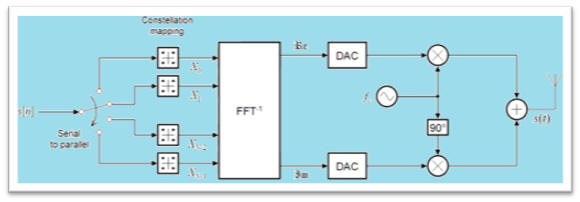|
All Optical Switching System
To reduce the scale of complexity and to
increase the variability, a simpler
wavelength routing OPS architecture
composed of tunable wavelength
converters, wideband optical filters,
and an arrayed waveguide grating has
been proposed and experimentally
demonstrated. As a result, simpler
traffic control and multi-function of
packet switching, multiplexing,
de-multiplexing, and add/drop were
achieved with prescribed wavelength
arrangement. |

 |
|

 |
OFDM (Orthogonal frequency-division
multiplexing)
OFDM (orthogonal frequency division
multiplexing) is a technology that is
widely applied in may communication
systems, such as: xDSL, DVB-H, WiMax,
..., etc. By dividing a high speed
channel into many low speed subchannels,
OFDM can greatly reduce signal’s
vulnerability from fiber dispersion, PMD
and nonlinearities. In addition, with
the advance of modern electronic
technologies, by using OFDM technology,
it’s much easier to generate high
efficient QAM signals without using
complicated optical
modulators/demodulators.
Since the first paper demonstrated the
feasibility of using OFDM in multi-mode
fiber communication system in the end of
2005, numerous optical OFDM
communication systems had been brought
out. |
|
Smart Sensing Network
We propose a mesh sensing system to
support more comprehensive sensing area
and self-healing functionality by
assigning and arranging the Bragg
wavelengths of FBGs and composing three
2x2 switches to realize the links and
nodes of the mesh topology,
respectively. In addition, for the
analysis of complicated sensing signals,
we also propose a simple and
cost-effective solution to classify and
analyze the signals from the sensing
system using the passive characteristics
of arrayed waveguide, cyclic filtering
and free spectral range. Moreover, since
the proposed architecture is always
regular and duplicate in frame, the mesh
sensing system can be modified and
extended to fit sensing areas of any
shape. |


|
|






